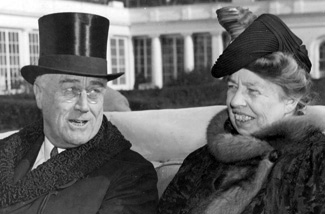As the Second World War raged, the leaders of the “Big Four” Allied nations sought to meet, even though they would risk life and limb to do so. The Japanese Empire separated America from China, while Nazi Germany divided the USSR from America and Britain. They found a neutral point in Tehran, Persia, where Russian Premier Stalin could come from the north, Chinese Chairman Chang Kai-shek could approach from the east, and American President Franklin Delano Roosevelt and British Prime Minister Winston Churchill could arrive from the west after a meeting shortly before in Cairo. They would discuss strategy for defeating the Axis powers as well as outlining post-war plans.
After a good deal of argument that the meetings would be strictly business between the immediate leaders and that women would not be allowed, First Lady Eleanor Roosevelt convinced her husband that she and their daughter Anna would be necessary as future leaders in their own rights (and supposedly asking whether he had anything to hide, which would become more obvious after FDR’s stroke in 1945 where mistress Lucy Rutherfurd was by his side). Roosevelt’s arguments proved hollow as they arrived in Cairo and were surprised to be met by Mrs. Churchill. When they continued on to Tehran, they would be joined by Madame Chiang Kai-shek, Soong May-ling. Joseph Stalin also attended the meeting, though his wife Nadezhda Alliluyeva had died in 1932 from apparent suicide (that was rumored to be actual murder at Stalin’s hand) after the two had a public argument. Stalin, Churchill, and Roosevelt formed a “Big Three” of the conference, edging out the war with the Japanese on the important matter of finishing off Germany with a European campaign.
While the men conferred, Eleanor gathered Mrs. Churchill and Chiang to tea on a number of occasions, which quickly turned into their own summit. Eleanor had long been a supporter of the Red Cross, while Mrs. Clementine Churchill was currently the Chairman of the Red Cross Aid to Russia Fund as well as a number of home front charitable efforts and Madame Kai-shek had worked to build and fund orphanages and schools for Nationalist "warphans," whose parents had been killed in the dark times of the past decade in China. They agreed on a number of matters that would eventually become important parts of shared efforts worldwide in 1945 when Mrs. Roosevelt became a representative and charter member of the United Nations Organization.
At one point in the conference, Mrs. Churchill noted Mr. Churchill’s worries about how eager FDR seemed to please the stony Stalin. Eleanor related the importance of the Soviet declaration of war against Japan once the Europe question was over, but Soong May-ling voiced concern they all shared that Stalin was working to ensure a powerful Soviet Bloc of buffer territory in Eastern Europe and would most likely soon be funding the communists in China to overthrow the republican government that would serve as the Japanese were driven out. The ladies’ concerns grew, and Eleanor and Clementine voiced their opinions to their husbands. FDR began to rethink his position, and Churchill redoubled his conviction that the world would not be safe from “the scourge and terror of war” as long as oppression in the Soviet Union remained.
Even with the distrust of Stalin growing uniformly, Churchill and FDR put into effect Operation Overlord headed by General Eisenhower that would begin a new front in France. Stalin, in return, promised to declare war on Japan, though the action would not follow until Germany was fully defeated. Meanwhile, the western Allies grew closer to Chiang Kai-shek, whose anti-communist sentiment spread. By the time of the conference in Yalta in February of 1945, feelings had shifted away from giving the Soviets direct control over much of anything outside of their prewar borders. The Morgenthau Plan to de-industrialize Germany was written off to keep down potential resistance, which infuriated Stalin, who began to demand why he bothered to fight a war if the rest of the Allies were simply going to let Germany rest to fight again. Unsatisfactory plans were agreed upon, though it was understood that, after the war, they would quickly be shelved.
After the taking of Berlin, threats of use of the A-bomb caused Stalin to retreat across Europe and acknowledge the International Zones. In China, support from America bolstered the Nationalist armies, which snuffed out the communist forces in China in 1947 after taking their capital at Yan'an. Stalin found himself surrounded with few allies, and he turned inward to develop his own atomic weapons. The “Cold War” standoff would continue for nearly a decade until 1956 brought attempted incursions into Hungary, threats over the Suez Canal, and the internal disputes over leadership after the death of Stalin. The weakness urged NATO to push for the dissolution of the Soviet government, resulting in a swift war that brought on a new Russian constitutional convention. UN aid bolstered the Russian people and eased tensions to ensure the new government would not fall to another predatory dictator.
--
In reality, FDR objected to the Roosevelt ladies attending the conference in Tehran. He held that no women would be allowed to attend, even though Mrs. Churchill and Madame Chiang Kai-shek both attended, which left Eleanor and Anna most displeased.

No comments:
Post a Comment